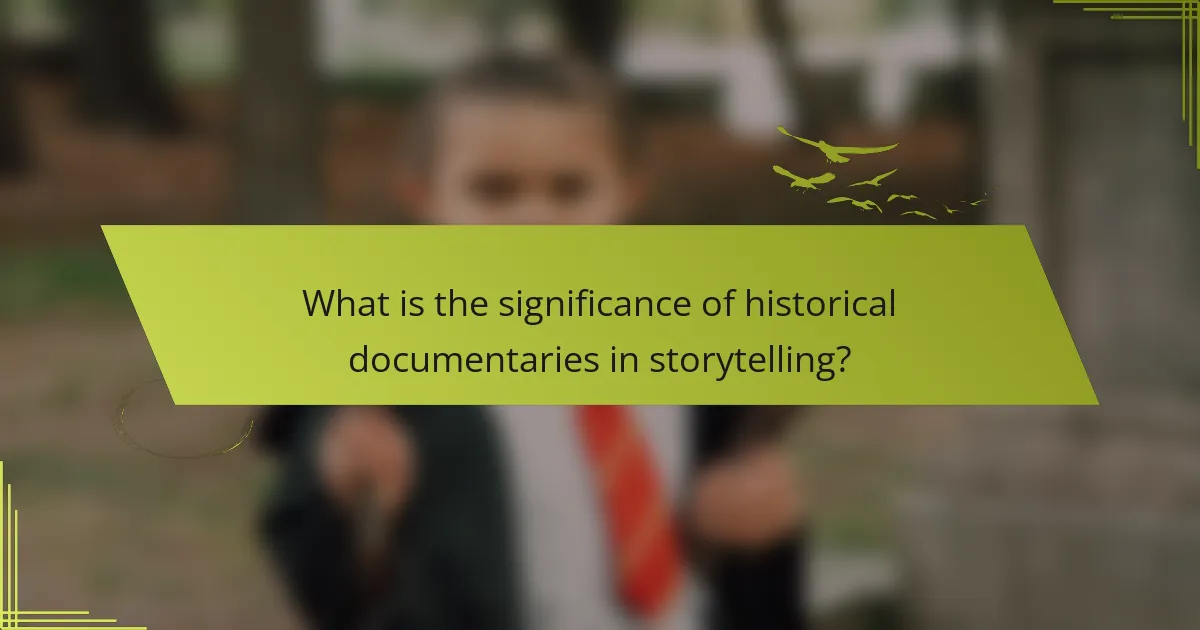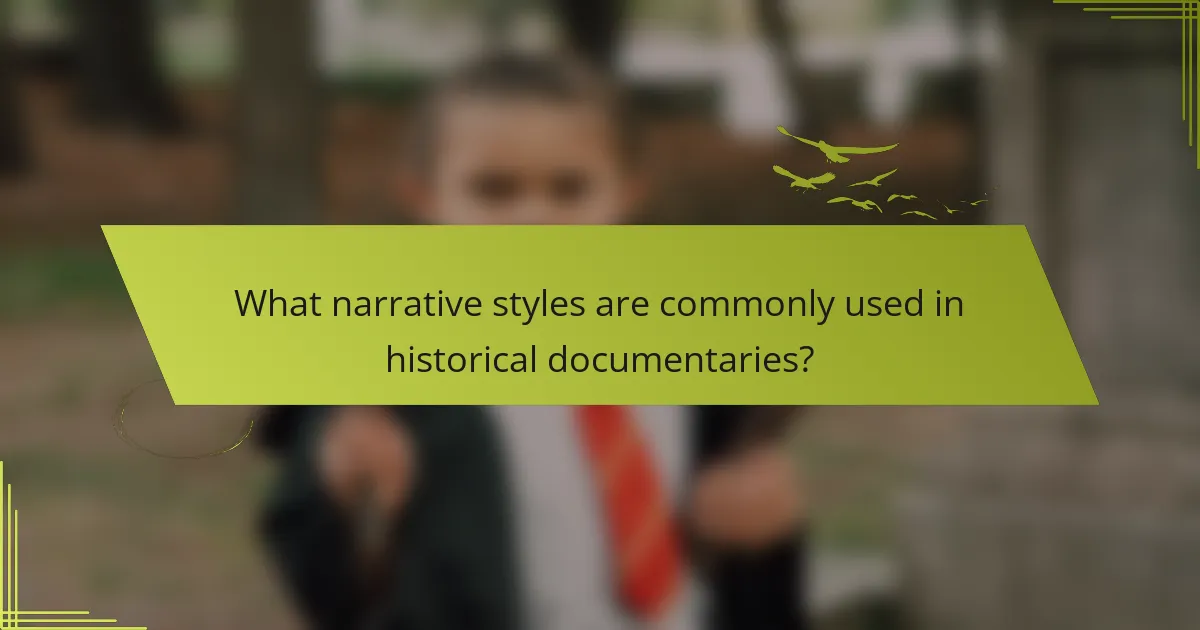
What is the significance of historical documentaries in storytelling?
Historical documentaries play a crucial role in storytelling by providing factual narratives of past events. They serve as visual records that preserve history for future generations. Through interviews, archival footage, and expert analysis, these films bring historical events to life. They help audiences understand complex issues by contextualizing them within a narrative framework. Historical documentaries also foster critical thinking by encouraging viewers to question perspectives and interpretations of history. For instance, Ken Burns’ “The Civil War” redefined documentary storytelling by blending personal stories with historical facts. This approach engages viewers emotionally while educating them about significant historical moments. Thus, historical documentaries are significant as they combine education and storytelling to enhance public understanding of history.
How have historical documentaries evolved over time?
Historical documentaries have evolved significantly over time. Initially, they focused on factual recounting of events, often resembling lectures. Early films, like “Nanook of the North” (1922), blended narrative with observation. The 1960s introduced a more subjective approach, emphasizing storytelling and emotional engagement. Filmmakers like Ken Burns popularized the use of archival footage and personal narratives. The advent of digital technology in the 1990s allowed for higher production values and accessibility. Today, streaming platforms have democratized distribution, enabling diverse voices and perspectives. This evolution reflects changing audience expectations and advancements in technology.
What are the key milestones in the development of historical documentaries?
The key milestones in the development of historical documentaries include the invention of the motion picture in the late 19th century. Early films, such as the 1895 “Workers Leaving the Lumière Factory,” introduced documentary storytelling. The 1920s saw the rise of the documentary movement, with films like “Nanook of the North” emphasizing real-life narratives. The introduction of sound in the late 1920s revolutionized the genre, allowing for more immersive storytelling.
In the 1960s, the direct cinema movement emerged, focusing on observational techniques. This era produced influential works like “Primary,” which captured the 1960 Wisconsin Democratic primary. The 1990s brought a surge in historical documentaries on television, with series like “The Civil War” by Ken Burns setting new standards for narrative depth.
In the 21st century, advancements in technology and online platforms expanded the accessibility of historical documentaries. This evolution reflects a growing public interest in history and storytelling.
How have technological advancements influenced historical documentary filmmaking?
Technological advancements have significantly influenced historical documentary filmmaking by enhancing production quality and accessibility. Innovations such as digital cameras have improved image clarity and color accuracy. Editing software has streamlined post-production, allowing filmmakers to create more engaging narratives. The use of drones has enabled aerial shots that provide unique perspectives on historical sites. Additionally, advancements in sound recording have improved audio quality, making documentaries more immersive. Online streaming platforms have expanded audience reach, allowing more viewers to access historical documentaries. These factors combined have transformed how historical events are portrayed and consumed.
What role do filmmakers play in shaping historical narratives?
Filmmakers play a crucial role in shaping historical narratives. They interpret and present historical events through their unique perspectives. This interpretation influences public understanding and perception of history. Filmmakers select which events to highlight and how to portray them. Their choices can emphasize certain viewpoints while downplaying others. For instance, films like “Schindler’s List” have brought attention to the Holocaust. Such portrayals can impact collective memory and cultural identity. Filmmakers also utilize artistic techniques to engage audiences emotionally. This engagement can foster a deeper connection to historical events. Through storytelling, filmmakers create a narrative framework that guides audience interpretation.
Who are the most influential filmmakers in the history of documentaries?
The most influential filmmakers in the history of documentaries include Robert Flaherty, John Grierson, and Werner Herzog. Robert Flaherty is known for “Nanook of the North,” which is considered the first feature-length documentary. John Grierson coined the term “documentary” and promoted the genre in the UK. Werner Herzog is celebrated for his unique storytelling style and films like “Grizzly Man.” Other notable filmmakers include D.A. Pennebaker, who pioneered direct cinema, and Ken Burns, known for his distinctive narrative style in historical documentaries. Their works have significantly shaped documentary filmmaking and its evolution.
What unique perspectives do different filmmakers bring to historical events?
Different filmmakers bring unique perspectives to historical events through their individual storytelling styles and cultural backgrounds. For instance, Ken Burns often emphasizes personal narratives and archival footage, creating an emotional connection to history. His documentary “The Civil War” showcases this approach, blending interviews and photographs to illustrate the human experience of the conflict.
In contrast, filmmakers like Errol Morris utilize innovative techniques such as reenactments and interviews with subjects to challenge traditional narratives. His film “The Fog of War” presents Robert S. McNamara’s reflections, offering a complex view of war and decision-making.
Moreover, international filmmakers may present historical events through the lens of their own cultural contexts. For example, Iranian filmmaker Abbas Kiarostami’s works often reflect on the impact of historical events on personal identity and society.
These diverse approaches contribute to a richer understanding of history by highlighting different aspects and interpretations of events. Each filmmaker’s unique perspective shapes how audiences perceive and engage with historical narratives.

What narrative styles are commonly used in historical documentaries?
Common narrative styles in historical documentaries include chronological, thematic, and first-person perspectives. Chronological narratives present events in the order they occurred. This style helps viewers understand the timeline of historical events clearly. Thematic narratives focus on specific themes or topics, allowing for a deeper exploration of particular issues. First-person narratives often include personal accounts or testimonies, adding emotional depth to the historical context. These styles enhance engagement and comprehension for the audience.
How do narrative styles impact audience engagement?
Narrative styles significantly impact audience engagement by shaping how stories are perceived and understood. Different styles, such as linear, non-linear, and interactive narratives, create varied emotional responses. For example, linear narratives provide clarity and ease of understanding. In contrast, non-linear styles can evoke curiosity and deeper cognitive engagement. Interactive narratives allow audiences to influence the story, increasing investment and emotional connection. Research indicates that documentaries using immersive storytelling techniques enhance viewer retention and emotional impact. A study by the University of Southern California found that emotionally engaging narratives increase audience connection by 30%. Thus, the choice of narrative style directly influences how effectively a documentary captivates its audience.
What are the characteristics of traditional narrative styles in historical documentaries?
Traditional narrative styles in historical documentaries often feature a linear storytelling structure. This structure typically follows a chronological timeline of events. Narration plays a crucial role, providing context and commentary. Visuals, including archival footage and photographs, are commonly used to support the narrative. Interviews with historians or experts add credibility to the information presented. The tone is usually authoritative, aiming to educate the audience. Emphasis is placed on factual accuracy and historical significance. These elements work together to create an engaging and informative viewing experience.
How have modern narrative techniques changed the presentation of historical content?
Modern narrative techniques have significantly transformed the presentation of historical content. These techniques include non-linear storytelling, immersive visuals, and interactive elements. Non-linear storytelling allows viewers to engage with historical events from multiple perspectives. Immersive visuals, such as high-quality animations and reenactments, enhance emotional connections. Interactive elements, like viewer choices in documentaries, create a personalized experience. According to a study by the University of Southern California, these techniques increase viewer retention and understanding of historical facts. This evolution in narrative style makes historical content more accessible and engaging for contemporary audiences.
What are the ethical considerations in creating historical documentaries?
Ethical considerations in creating historical documentaries include accuracy, representation, and sensitivity. Documentarians must ensure factual accuracy to avoid misleading viewers. This involves thorough research and fact-checking of historical events. Representation of diverse perspectives is crucial to provide a comprehensive view of history. Ignoring certain narratives can perpetuate biases. Sensitivity to the subjects involved is also essential. Documentaries should handle traumatic events with care to respect the experiences of those affected. Additionally, ethical considerations include transparency about sources and potential conflicts of interest. By adhering to these principles, filmmakers can create responsible and impactful historical narratives.
How do filmmakers ensure accuracy and objectivity in their storytelling?
Filmmakers ensure accuracy and objectivity in their storytelling by conducting thorough research. They often consult historians and experts in relevant fields. This collaboration helps to verify facts and provide context. Filmmakers also utilize primary sources, such as documents and interviews with witnesses. By incorporating diverse perspectives, they aim to present a balanced view. Additionally, filmmakers may employ peer review processes for their scripts. This helps identify potential biases or inaccuracies. Documentaries often include citations of sources to enhance credibility. These practices contribute to a more reliable narrative in historical documentaries.
What challenges do filmmakers face in representing sensitive historical events?
Filmmakers face significant challenges in representing sensitive historical events. One challenge is balancing factual accuracy with emotional impact. Filmmakers must ensure that their narratives are historically correct while evoking the intended emotional responses from audiences. Another challenge is navigating the differing perspectives of those affected by the events. Diverse viewpoints can complicate storytelling and lead to controversy. Additionally, filmmakers often contend with potential backlash from communities or groups who may feel misrepresented. This can result in public criticism or calls for censorship. The ethical implications of dramatizing real events also pose a challenge. Filmmakers must consider the potential harm to survivors and descendants of those impacted. Furthermore, financial constraints can limit the scope of production, affecting the depth of research and representation. Overall, these challenges require filmmakers to approach sensitive historical events with care and responsibility.

How can viewers critically analyze historical documentaries?
Viewers can critically analyze historical documentaries by assessing their sources and evidence. Evaluating the credibility of the information presented is essential. Viewers should identify the filmmakers’ perspectives and potential biases. Analyzing the documentary’s narrative structure helps understand its storytelling techniques. Comparing the documentary with established historical facts is crucial for accuracy. Viewers should consider the inclusion or exclusion of differing viewpoints. Understanding the context in which the documentary was made provides additional insight. Engaging with critiques and reviews can enhance the analysis process.
What questions should viewers ask when watching a historical documentary?
Viewers should ask questions that critically engage with the content of a historical documentary. Key questions include: What is the main thesis or argument presented? Who are the primary sources of information used? How does the documentary interpret historical events? What biases might the filmmakers have? Are there alternative perspectives not represented? What evidence supports the claims made? How does the documentary’s narrative style influence understanding? What is the historical context of the events portrayed? These questions help viewers analyze the documentary’s credibility and depth.
How can understanding the filmmaker’s perspective enhance the viewing experience?
Understanding the filmmaker’s perspective enhances the viewing experience by providing context and insight into the narrative choices made. This perspective allows viewers to grasp the filmmaker’s intent and thematic focus. Recognizing the filmmaker’s background can reveal biases and influences that shape the documentary. For instance, a filmmaker’s personal experiences may inform their portrayal of historical events. This understanding fosters a deeper emotional connection to the material. It can also encourage critical thinking about the representation of facts. A study by Bill Nichols highlights the importance of perspective in documentary filmmaking. This research indicates that awareness of perspective leads to more engaged and thoughtful audiences.
What common pitfalls should viewers be aware of in historical documentaries?
Common pitfalls viewers should be aware of in historical documentaries include bias, oversimplification, and lack of context. Bias can occur when filmmakers present a one-sided narrative, ignoring opposing viewpoints. Oversimplification happens when complex events are reduced to simplistic explanations, which can mislead audiences. Lack of context may result in viewers not fully understanding the significance of events or figures presented. Additionally, dramatization can lead to misrepresentation, as filmmakers may prioritize entertainment over factual accuracy. Critical viewing is essential to discern these issues.
What are some recommended practices for aspiring historical documentary filmmakers?
Aspiring historical documentary filmmakers should focus on thorough research and storytelling. Understanding historical context is crucial for accuracy. Filmmakers must verify facts using primary and secondary sources. Engaging narratives help connect audiences to the subject matter. Visual elements should support the storytelling, enhancing viewer engagement. Collaborating with historians can provide deeper insights into the topic. Filmmakers should also consider ethical implications when representing history. Networking with other professionals can lead to valuable opportunities and mentorship.
What skills are essential for success in historical documentary filmmaking?
Essential skills for success in historical documentary filmmaking include research proficiency, storytelling ability, and technical expertise. Research proficiency allows filmmakers to gather accurate historical information. This ensures credibility in the narrative. Storytelling ability is crucial for engaging audiences. A compelling narrative can transform factual content into an emotional experience. Technical expertise encompasses skills in cinematography, sound, and editing. Mastery of these technical elements enhances the overall production quality. Collaboration skills are also vital, as filmmakers often work with historians and other professionals. Effective communication fosters a productive working environment. Adaptability is important to navigate challenges during production. Each of these skills contributes to creating impactful historical documentaries.
How can filmmakers effectively research and present historical topics?
Filmmakers can effectively research and present historical topics by utilizing primary and secondary sources. Primary sources include original documents, photographs, and interviews with eyewitnesses. Secondary sources consist of books, scholarly articles, and documentaries that analyze historical events. Filmmakers should also consult experts in relevant fields to gain deeper insights. Engaging with historical societies and archives can provide access to rare materials. Additionally, filmmakers must critically evaluate sources for credibility and bias. Presenting historical topics requires a clear narrative structure to guide the audience. Visual storytelling techniques, such as reenactments and animations, can enhance understanding. Accurate representation of events is crucial to maintain historical integrity.
The main entity of the article is historical documentaries, which serve as visual records that preserve and narrate past events. The article explores the evolution of historical documentaries, highlighting key milestones and influential filmmakers who have shaped the genre. It examines various narrative styles, the impact of technological advancements, and the ethical considerations filmmakers face. Additionally, the article provides insights into how viewers can critically analyze these documentaries and the skills necessary for aspiring filmmakers. Overall, it emphasizes the significance of historical documentaries in enhancing public understanding of history.